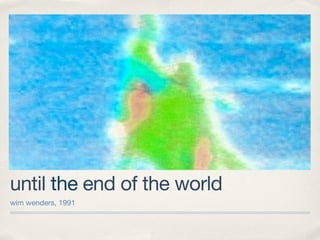Until The End Of The World
- 1. until the end of the world wim wenders, 1991
- 2. The phones both wireless and attached are video messaging phones so that when people communicate with one another they not only hear each other but they can also see each other. This is intentional because it stresses the importance of seeing. Having video phones shows that it is essential for people to see one another to understand each other. Which is the mission that Sam is trying to accomplish; his mother to obtain sight. -Abby
- 3. The one rule of the Road Movie is that the journey is always more important than the destination. However the globe-trotting in UTEOTW is a means to an end. The goal, perfecting the device, is more important than the actual act of traveling. -Bryce
- 4. In each episode, there is a challenge to be met, although not all of them will be met successfully.    In most scenes, a piece of the plot is revealed - knowledge or allies are gained, and so on.   Sometimes, as in Heart of Darkness, this progress is inverted, and each episode represents a loss rather than a gain.
- 5. Road movies traditionally end in one of four ways: having met with triumph at their ultimate destination, the protagonist(s) return home, wiser for their experiences. at the end of the journey, the protagonist(s) find a new home at their destination. the journey continues endlessly. having realized that, as a result of their journey, they can never go home, the protagonists either choose death or are killed.
- 6. His characters seem obsessed with polaroids, both as hand-held devices and fixed booths. I believe that these polaroids offered a tangible proof of their existence amongst the chaos of their every changing and transitive world. As the plot and film progress at an alarming, and arguably confusing pace, the Polaroids serve as the physical reminder of what had already happened. For the characters, I think they were meant to capture and remember their identity. For the viewers, I believe they were meant to illustrate Wenders contention that amongst the infinitely undefined universe, individuals are constantly struggling to find their vision of themselves. -Alicia
- 7. Wenders' discussion was heavily oriented towards the brain rather than the eye, as the eye itself is really just a conduit. All of the crazy processing and analysis—i.e. the stuff that makes an image an image, rather than a random assemblage of light particles—is the essence of sight, and that's entirely the brain's department. -Lauren
- 8. The goggles proved that it was not the actual images that were being seen that mattered, but rather the invisible love beneath them that the goggles symbolized and brought forth. -Kaitlin
- 9. I find this disturbing. I have little appreciation for this “electronic artwork” as a legitimate form of fine art. They appear to be untouched by the creative mind, I see little reflection of the humanity I connect with in other artwork. In this image I see mathematical formulas, the confounding process of all that is digital and technological, the sciences, time travel, the mysteries of scifi. -Noelle
- 11. Wenders on images... ✤ We gasp and give a start when we suddenly discover something true or real in a movie, be it nothing more than the gesture of a child in the background, or a bird flying across the frame, or a cloud casting its shadow over the scene but for an instant. It is a rarity in today’s cinema to find such moments of truth, for people or objects to show themselves as they really are. --from the film The State of Things (1982)
Editor's Notes
- #5: The genre has its roots in spoken and written tales of epic journeys, such as the Odyssey and the Aeneid. The road film is a standard plot employed by screenwriters. It is a kind of bildungsroman, a kind of story in which the hero changes, grows or improves over the course of the story. The modern "road picture" is to filmmakers what the heroic quest was to Medieval writers.   The "road picture" as a genre came only in the 1960s with Easy Rider and Bonnie and Clyde.   In Easy Rider, Wyatt complains that his life is like being in a road movie. Like their antecedents, the road movie tends towards an episodic structure... I











